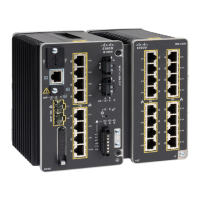21-23
Cisco IE 3000 Switch Software Configuration Guide
OL-13018-01
Chapter 21 Configuring IGMP Snooping and MVR
Configuring IGMP Filtering and Throttling
Configuring IGMP Filtering and Throttling
In some environments, for example, metropolitan or multiple-dwelling unit (MDU) installations, you
might want to control the set of multicast groups to which a user on a switch port can belong. You can
control the distribution of multicast services, such as IP/TV, based on some type of subscription or
service plan. You might also want to limit the number of multicast groups to which a user on a switch
port can belong.
With the IGMP filtering feature, you can filter multicast joins on a per-port basis by configuring IP
multicast profiles and associating them with individual switch ports. An IGMP profile can contain one
or more multicast groups and specifies whether access to the group is permitted or denied. If an IGMP
profile denying access to a multicast group is applied to a switch port, the IGMP join report requesting
the stream of IP multicast traffic is dropped, and the port is not allowed to receive IP multicast traffic
from that group. If the filtering action permits access to the multicast group, the IGMP report from the
port is forwarded for normal processing. You can also set the maximum number of IGMP groups that a
Layer 2 interface can join.
IGMP filtering controls only group-specific query and membership reports, including join and leave
reports. It does not control general IGMP queries. IGMP filtering has no relationship with the function
that directs the forwarding of IP multicast traffic. The filtering feature operates in the same manner
whether CGMP or MVR is used to forward the multicast traffic.
IGMP filtering is applicable only to the dynamic learning of IP multicast group addresses, not static
configuration.
With the IGMP throttling feature, you can set the maximum number of IGMP groups that a Layer 2
interface can join. If the maximum number of IGMP groups is set, the IGMP snooping forwarding table
contains the maximum number of entries, and the interface receives an IGMP join report, you can
configure an interface to drop the IGMP report or to replace the randomly selected multicast entry with
the received IGMP report.
Note IGMPv3 join and leave messages are not supported on switches running IGMP filtering.
These sections contain this configuration information:
• Default IGMP Filtering and Throttling Configuration, page 21-24
• Configuring IGMP Profiles, page 21-24 (optional)
• Applying IGMP Profiles, page 21-25 (optional)
• Setting the Maximum Number of IGMP Groups, page 21-26 (optional)
• Configuring the IGMP Throttling Action, page 21-26 (optional)
show mvr members [ip-address] Displays all receiver and source ports that are members of any IP multicast group or the
specified IP multicast group IP address.
Table 21-6 Commands for Displaying MVR Information (continued)
Command Purpose
show mvr Displays MVR status and values for the switch—whether MVR is enabled or disabled,
the multicast VLAN, the maximum (256) and current (0 through 256) number of
multicast groups, the query response time, and the MVR mode.
